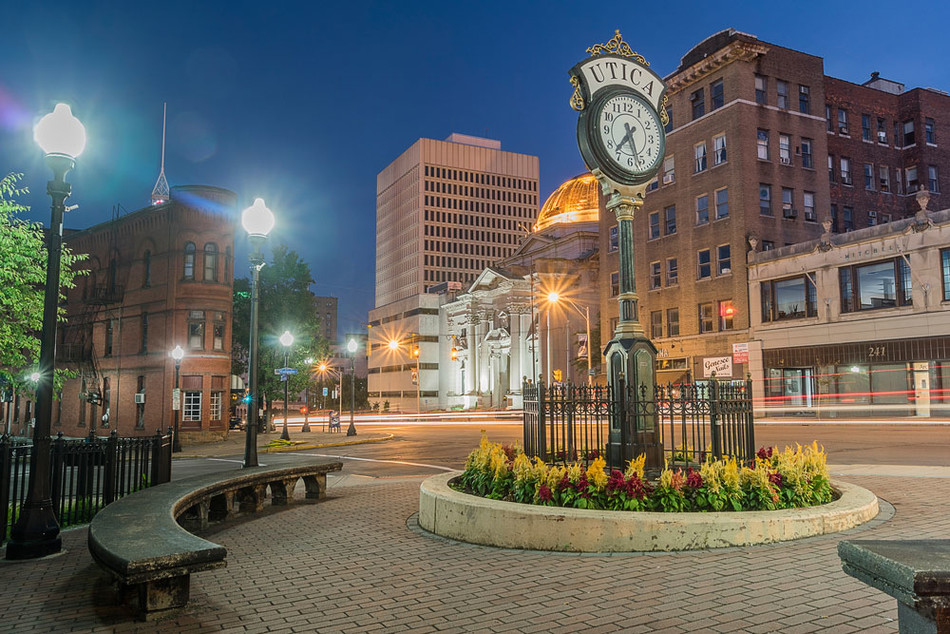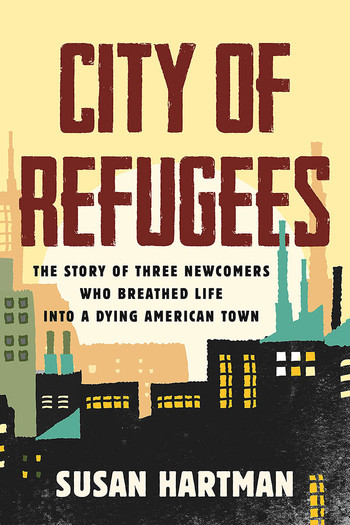Nobody loves a comeback story quite like the American public, whose soft spot for scrappy underdogs is legendary. In City of Refugees, by journalist Susan Hartman ’76SOA, the comeback kid is the once-thriving city of Utica, located in the Rust Belt of upstate New York. On the decline since the 1970s, Utica reached its nadir in the mid-1990s, not long after General Electric, the last major employer in the area, pulled up stakes. In the aftermath, thousands of out-of-work Uticans simply vacated their homes, and an epidemic of arson — often by absentee landlords for insurance money — lay waste to buildings across the city.
Utica needed a hero, and it ended up with thousands of them: an influx of refugees from thirty-five different countries who have come to the area, thanks largely to the presence of The Center, a nonprofit that resettles people displaced by violence, persecution, war, and climate catastrophes. Taking jobs shunned by locals, learning English, starting businesses, pooling their cash and buying and rehabbing dilapidated houses, these new residents have slowly rekindled Utica’s economy and in the process effected a subtle shift toward greater pluralism in the city’s culture.
Whether through luck or careful culling, Hartman, who immersed herself in the town and its people from 2013 to 2021, hit the jackpot with her choice of subjects: Sadia Ambure, a Somali Bantu girl who is fifteen when we meet her; Ali Sarhan, forty-five, a professional interpreter from Iraq who used to work for ABC News in Baghdad; and Mersiha Omeragic, forty, an ESL teacher and baker who, along with her husband, Hajrudin, was part of an influx of Bosnians into Utica in the mid-1990s.
Like the city that they helped revive, Sadia, Ali, and Mersiha are easy to root for. But there is an ironic twist to this classic comeback tale: all three practice Islam, a religion that has long faced knee-jerk antipathy in America — so much so that this bigotry was enshrined in US policy (see Executive Order 13769 and its successors, collectively known as “the Muslim ban”) for four of the eight years covered by Hartman’s book. It is an injustice the book wears lightly, as befits a writer of Hartman’s subtlety and skill, but it nonetheless pervades her moving and inspiring narrative.
Sadia lives with eighteen family members in a grand, if rundown, thirteen-bedroom house that her grandmother bought for $55,000 in 2011, seven years after the family’s arrival in the US. Beset by the usual adolescent angst, Sadia straddles two worlds, feeling at home in neither: the American pop culture of Michael Kors bags, iPhones, and Subway sandwiches, and the traditional Bantu culture that demands she help with the housework, take care of siblings, and show absolute obedience to her strong-willed mother.
Ali is also torn between competing worlds. A warm-hearted, highly educated man, he is largely content with the life he has forged in Utica — particularly his relationship with his girlfriend, Heidi, a free-spirited local woman. But he desperately misses his mother and two sisters back in Baghdad and is haunted by memories of his brother, who was abducted and murdered by al-Qaeda in 2006, two years before Ali fled to the US. Ali also has financial problems: an interpreter who works with Arabic speakers in Utica, he sees his income plummet when the policies of Donald Trump (for whom Ali votes in 2016) take hold, halting the flow of Arabic-speaking refugees to the area.
Bosnian-born Mersiha is a dynamo whose work ethic seems at times to defy human limitations. She is a talented baker who makes wedding and birthday cakes as a side hustle to her full-time job as an ESL teacher, but she harbors dreams of opening her own café. The unstoppable manner in which Mersiha and her equally hard-working husband, Hajrudin (a survivor of a Serbian-run concentration camp), set out to realize their American dream — meeting and defeating a host of nearly insuperable obstacles every step of the way — is not merely awe-inducing: it should be taught in MBA programs as a model of small-business perseverance and the ability to pivot in a crisis.
While this is an uplifting book animated by a spirit of can-do optimism, Hartman does not sentimentalize the lives of Utica’s refugees, which tend to be complicated, exhausting, and often lonely. Nor does she spare readers the details of the circumstances that turned them into refugees in the first place. Even in a time when war atrocities flit across our screens hourly, Hartman’s vividly rendered accounts of what these refugees endured — being forced to abandon newborn twins during a frantic flight from the enemy; being enslaved on their own land by armed interlopers; being beaten, humiliated, and tortured by former compatriots — are heart-stopping in the anguish they depict.
But also deeply enlightening. Regardless of where you are on the political spectrum or what position you take in the endless debates about refugees (or their close cousins, immigrants), reading this book will likely change your perspective on those issues and much more.




